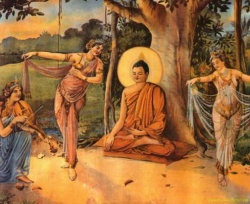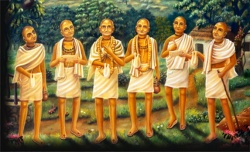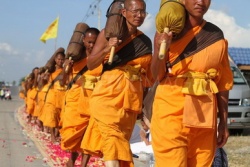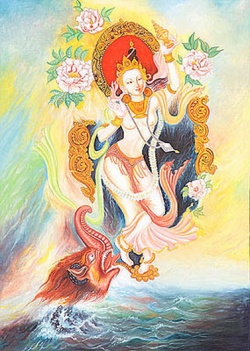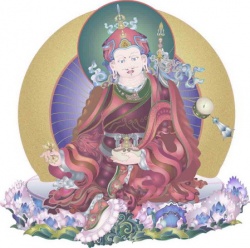Difference between revisions of "Siddhi"
| (4 intermediate revisions by the same user not shown) | |||
| Line 1: | Line 1: | ||
| − | [[File:Hevajrah99.jpg|thumb|250px|]] | + | [[File:Hevajrah99.jpg|thumb|250px|]]{{DisplayImages|2792|343|1309|2125|0|278}}<nomobile>{{DisplayImages|509|144|578|1637|1829}}</nomobile> |
| + | |||
| + | |||
| + | |||
| + | |||
| + | |||
| + | |||
| + | |||
| + | |||
| + | |||
'''[[Siddhi]]''' ({{Wiki|Devanagari}} [[सिद्धि]]; IAST: [[siddhi]]; [[Tibetan]]: {{BigTibetan|[[དངོས་གྲུབ]]}}, [[Wylie]]: [[dngos grub]]) is a [[Sanskrit]] {{Wiki|noun}} that can be translated as "[[perfection]]", "[[accomplishment]]", "[[attainment]]", or "[[success]]". | '''[[Siddhi]]''' ({{Wiki|Devanagari}} [[सिद्धि]]; IAST: [[siddhi]]; [[Tibetan]]: {{BigTibetan|[[དངོས་གྲུབ]]}}, [[Wylie]]: [[dngos grub]]) is a [[Sanskrit]] {{Wiki|noun}} that can be translated as "[[perfection]]", "[[accomplishment]]", "[[attainment]]", or "[[success]]". | ||
| Line 34: | Line 43: | ||
| − | The thirty-ninth [[chapter]] of the [[Brahmavaivarta]] | + | The thirty-ninth [[chapter]] of the [[Brahmavaivarta Purana]] mentions eighteen kinds, but there are many others, including such [[minor accomplishments]] as [[nakhadarpana siddhi]] or "[[nail-gazing]]." |
| − | The great [[siddhi]] is [[spiritual | + | The great [[siddhi]] is [[spiritual perfection]]. |
Even the mighty [[powers]] of the "[[eight siddhi]]" are known as the "lesser [[siddhi]]," since the greatest of all [[siddhi]] is full [[Liberation]] ([[mahanirvana]]) from the bonds of [[phenomenal]] [[Life]] and union with the [[Paramatma]], which is the supreme [[object]] ([[paramartha]]) to be [[attained]] through [[human]] [[birth]]. | Even the mighty [[powers]] of the "[[eight siddhi]]" are known as the "lesser [[siddhi]]," since the greatest of all [[siddhi]] is full [[Liberation]] ([[mahanirvana]]) from the bonds of [[phenomenal]] [[Life]] and union with the [[Paramatma]], which is the supreme [[object]] ([[paramartha]]) to be [[attained]] through [[human]] [[birth]]. | ||
| Line 42: | Line 51: | ||
[[File:Siddhielix.jpg|thumb|250px|Magical accomplishment siddhi nectar elixir transmission. | [[File:Siddhielix.jpg|thumb|250px|Magical accomplishment siddhi nectar elixir transmission. | ||
| − | The [[Dalai Lama's Secret Temple]], [[Tantric]] Wall Paintings from [[Tibet]], Ian Baker, Thomas Laird. | + | The [[Dalai Lama's Secret Temple]], [[Tantric]] Wall Paintings from [[Tibet]], [[Ian Baker]], Thomas Laird. |
| − | In the | + | In the [[Samkhya Karika]] and [[Tattva Samasa]], it refers to the [[attainment]] of eight [[Siddhis]] that make one become rid of pain-causing [[Ignorance]], to gain [[Knowledge]], and [[experience]] [[bliss]]. |
In [[Tantric Buddhism]], it specifically refers to the acquisition of [[supernatural powers]] by [[psychic]] or [[magical]] means or the supposed {{Wiki|faculty}} so acquired. | In [[Tantric Buddhism]], it specifically refers to the acquisition of [[supernatural powers]] by [[psychic]] or [[magical]] means or the supposed {{Wiki|faculty}} so acquired. | ||
| Line 54: | Line 63: | ||
| − | In [[Patanjali's]] [[Yoga | + | In [[Patanjali's]] [[Yoga Sutras]] IV.1 it is stated (rendered in IAST): |
| Line 60: | Line 69: | ||
| − | where [[janma]] ("[[birth]]"), | + | where [[janma]] ("[[birth]]"), [[auṣadhi]] ("[[medicinal plant]], herb, {{Wiki|drug}}, [[Incense]], [[elixir]]"), [[Mantra]] ("incantation, charm, spell"), [[tapaḥ]] ("heat, burning, shining, as [[ascetic]] devotional [[practice]], |
| − | |||
| − | [[auṣadhi]] ("[[medicinal plant]], | ||
| − | |||
| − | herb, {{Wiki|drug}}, | ||
| − | |||
| − | [[Incense]], [[elixir]]"), | ||
| − | |||
| − | [[Mantra]] ("incantation, charm, spell"), | ||
| − | |||
| − | [[tapaḥ]] ("heat, burning, shining, as [[ascetic]] devotional [[practice]] | ||
| − | |||
| − | |||
| − | |||
| − | |||
| − | [[jāḥ]] ("born") and [[siddhayaḥ]] ("[[perfections]], | + | burning [[desire]] to reach [[perfection]], that which burns all [[impurities]]"), [[Samādhi]] ("profound [[Meditation]], total [[absorption]]"), [[jāḥ]] ("born") and [[siddhayaḥ]] ("[[perfections]], |
accomplishments, fulfillment's, [[attainments]]") are rendered in English by Iyengar (1966, 2002: p. 246) thus: | accomplishments, fulfillment's, [[attainments]]") are rendered in English by Iyengar (1966, 2002: p. 246) thus: | ||
| Line 96: | Line 91: | ||
* [[tri-kāla-jñatvam]]: [[knowing the past, present and future]] | * [[tri-kāla-jñatvam]]: [[knowing the past, present and future]] | ||
* [[advandvam]]: [[tolerance of heat, cold and other dualities]] | * [[advandvam]]: [[tolerance of heat, cold and other dualities]] | ||
| − | * [[para Citta ādi abhijñatā]]: | + | * [[para Citta ādi abhijñatā]]: [[knowing the minds of others and so on]] |
* [[agni arka ambu viṣa ādīnām pratiṣṭambhaḥ]]: [[checking the influence of Fire, sun, water, poison, and so on]] | * [[agni arka ambu viṣa ādīnām pratiṣṭambhaḥ]]: [[checking the influence of Fire, sun, water, poison, and so on]] | ||
* [[aparājayah]]: [[remaining unconquered by others]] | * [[aparājayah]]: [[remaining unconquered by others]] | ||
| Line 103: | Line 98: | ||
== [[Eight primary Siddhis]] == | == [[Eight primary Siddhis]] == | ||
| − | [[File:AshtaSiddhi.jpg|thumb|250px|[[Ganesha]] with the ashta (eight) [[siddhis]]. | + | [[File:AshtaSiddhi.jpg|thumb|250px|[[Ganesha]] with the [[ashta]] (eight) [[siddhis]]. |
| − | The [[Ashtasiddhi]] are shown as attendants of [[Ganesha]]. Painting by [[Raja | + | The [[Ashtasiddhi]] are shown as attendants of [[Ganesha]]. Painting by [[Raja Ravi Varma]] (1848-1906).]] |
Latest revision as of 06:32, 27 December 2015
Siddhi (Devanagari सिद्धि; IAST: siddhi; Tibetan: དངོས་གྲུབ, Wylie: dngos grub) is a Sanskrit noun that can be translated as "perfection", "accomplishment", "attainment", or "success".
The term is first attested in the Mahabharata.
In the Pancatantra, a siddhi may be any unusual skill or faculty or capability.
As a term in the Manusmriti, it refers to the settlement of a debt.
Siddhi is produced by sadhana.
The former term, which literally means "success," includes accomplishment, achievement, success, and fruition of all kinds.
A person may thus gain siddhi in speech, siddhi in Mantra, etc.
A person is Siddha also who has perfected his spiritual development.
The various powers attainable – namely,
the powers of becoming small, great, Light, heavy, attaining what one wills, and the like – are known as the eight siddhi.
The thirty-ninth chapter of the Brahmavaivarta Purana mentions eighteen kinds, but there are many others, including such minor accomplishments as nakhadarpana siddhi or "nail-gazing."
The great siddhi is spiritual perfection.
Even the mighty powers of the "eight siddhi" are known as the "lesser siddhi," since the greatest of all siddhi is full Liberation (mahanirvana) from the bonds of phenomenal Life and union with the Paramatma, which is the supreme object (paramartha) to be attained through human birth.
[[File:Siddhielix.jpg|thumb|250px|Magical accomplishment siddhi nectar elixir transmission.
The Dalai Lama's Secret Temple, Tantric Wall Paintings from Tibet, Ian Baker, Thomas Laird.
In the Samkhya Karika and Tattva Samasa, it refers to the attainment of eight Siddhis that make one become rid of pain-causing Ignorance, to gain Knowledge, and experience bliss.
In Tantric Buddhism, it specifically refers to the acquisition of supernatural powers by psychic or magical means or the supposed faculty so acquired.
These powers include items such as clairvoyance, levitation, bilocation, becoming as small as an atom, materialization, having access to memories from past lives, etc.
The term is also used in this sense in the Sarva-darśana-saṃgraha of Madhvacharya (1238–1317).
In Patanjali's Yoga Sutras IV.1 it is stated (rendered in IAST):
where janma ("birth"), auṣadhi ("medicinal plant, herb, drug, Incense, elixir"), Mantra ("incantation, charm, spell"), tapaḥ ("heat, burning, shining, as ascetic devotional practice,
burning desire to reach perfection, that which burns all impurities"), Samādhi ("profound Meditation, total absorption"), jāḥ ("born") and siddhayaḥ ("perfections,
accomplishments, fulfillment's, attainments") are rendered in English by Iyengar (1966, 2002: p. 246) thus:
- Accomplishments may be attained through birth, the use of herbs, incantations, self-discipline or Samadhi.
Five Siddhis of Yoga and Meditation
In the Bhagavata purana, the five Siddhis of Yoga and Meditation are described as below:
- tri-kāla-jñatvam: knowing the past, present and future
- advandvam: tolerance of heat, cold and other dualities
- para Citta ādi abhijñatā: knowing the minds of others and so on
- agni arka ambu viṣa ādīnām pratiṣṭambhaḥ: checking the influence of Fire, sun, water, poison, and so on
- aparājayah: remaining unconquered by others
== Eight primary Siddhis ==
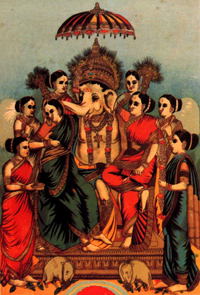
The Ashtasiddhi are shown as attendants of Ganesha. Painting by Raja Ravi Varma (1848-1906).
There is the concept of the Ashta Siddhi (eight Siddhis) in Hinduism.
These are:
- Aṇimā: reducing one's Body even to the size of an atom
- Mahima: expanding one's Body to an infinitely large size
- Garima: becoming infinitely heavy
- Laghima: becoming almost weightless
- Prāpti: having unrestricted access to all places
- Prākāmya: realizing whatever one desires
- Iṣṭva: possessing absolute lordship
- Vaśtva: the Power to subjugate all
The eight Siddhis hinted at by Kapila in his Sutra - अष्टधा सिद्धिः ||१५|| - are as explained in Verse 51 of Samkhyakarika :-
- Uuha: based on the samskaras of previous births the attainment of Knowledge about the twenty-four Tatwas gained by examining the determinable and the indeterminable conscious and the non-conscious constituents of creation,
- Shabad: Knowledge gained by associating with an enlightened person (Guru – upadesh),
- Addhyyan: Knowledge gained through study of the Vedas and other standard ancillary texts,
- Suhritprapti: Knowledge gained from a kind-hearted person, while engaged in the spread of Knowledge
- Daan: Knowledge gained regardless of one’s own needs while attending to the requirements of those engaged in the search of the highest Truth,
- Aadhyaatmik dukkh-haan: freedom from pain, disappointment, etc; arising due to lack of spiritual, metaphysical,mystic Knowledge and experience,
- Aadhibhautik dukkh-haan: freedom from pain etc; arising by possessing and being attached to various materialistic gains,
- Aadhidaivik dukkh-haan: freedom from pain etc; caused by fate or due to reliance on fate,
the attainment of which eight Siddhis makes one become rid of pain-causing Ignorance through gain of Knowledge, and experience bliss.
The aim of Samkhya is to eliminate all kinds of physical and Mental pains and to receive Liberation.
Ten secondary Siddhis
In the Bhagavata purana, Lord Krishna describes the ten secondary Siddhis as:
- anūrmi-mattvam: Being undisturbed by hunger, thirst, and other bodily disturbances
- dūra-śravaṇa: Hearing things far away
- dūra-darśanam: Seeing things far away
- manaḥ-javah: Moving the Body wherever Thought goes (teleportation/astral projection)
- Kāma-rūpam: Assuming any Form desired
- para-Kāya praveśanam: Entering the bodies of others
- sva-Chanda mṛtyuh: Dying when one desires
- devānām saha krīḍā anudarśanam: Witnessing and participating in the pastimes of the gods
- yathā sańkalpa saḿsiddhiḥ: Perfect accomplishment of one's determination
- ājñā apratihatā gatiḥ: Orders or commands being unimpeded
Hindu gods associated with gaining siddhi
In Hinduism, both Ganesha and Hanuman possess the eight supernatural powers (ashtamahasiddhis) and can give one access to Ashta Siddhis.
Skt., siddhi: accomplishment, a skill perfected Tib., dngos-grub: accomplishment, ability of perfection
Term for a type of spiritual and/or mental accomplishment that we can best approximate with modern expressions such as ESP (Extra Sensory Perception) and/or with Colin Wilson's (b. 1931) Faculty X. Phrases such as mystical power, paranormal potential and magical skill are also often used to cover these phenomena.
Vajrayana texts speak of eight types of siddhi only, but one can find a much more detailed classification in the Hindu Tantras, where 84 are recognized. Among these, several phenomena can be found which correspond to those charted by contemporary para-psychology, for example psychokinesis, telekinesis and the astral 'double'.
All of these, of course, we also find when studying shamanism - and there is little doubt that Tibetan Buddhism has been very much influenced by that ancient, ‘magic’ oriented religion. The following list shows the Sanskrit names for some of the better known siddhis.
anima: decreasing one's size at will
antardhana: making oneself invisible
kamarupitva: assuming forms at will
kamavasaita: power to control one's passion
khecara: the power to fly
kramana: the power to enter another person's body (i.e. possession)
laghiman: the power to cancel out gravity (i.e. levitation)
mahima: increasing one's size at will
mohana: rendering a person unconscious
manojavitva: achieving high speed
padalepa: to move about anywhere, unnoticed
prapti: the power of obtaining everything
prakamya: irresistible willpower
stambhana: causing temporary paralysis in someone
vasitva: control over others
vikaranadharmitva: infinite mental powers
The term siddhi is also at the root of the title for the 84 Greatly Accomplished Ones (Skt., Mahasiddhas), each of whom had achieved one of more of these 'perfections'.


